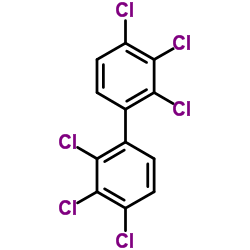PCB No(Aroclor 1260)158 solution

PCB No(Aroclor 1260)158 solution structure
|
Common Name | PCB No(Aroclor 1260)158 solution | ||
|---|---|---|---|---|
| CAS Number | 11096-82-5 | Molecular Weight | 360.878 | |
| Density | 1.6±0.1 g/cm3 | Boiling Point | 403.8±40.0 °C at 760 mmHg | |
| Molecular Formula | C12H4Cl6 | Melting Point | 115.76°C (estimate) | |
| MSDS | N/A | Flash Point | 198.9±24.7 °C | |
| Symbol |




GHS02, GHS07, GHS08, GHS09 |
Signal Word | Danger | |
|
Extensive biodegradation of polychlorinated biphenyls in Aroclor 1242 and electrical transformer fluid (Askarel) by natural strains of microorganisms indigenous to contaminated African systems
Chemosphere 73(1) , 126-32, (2008) Evidence for substantial aerobic degradation of Aroclor 1242 and Askarel fluid by newly characterized bacterial strains belonging to the Enterobacter, Ralstonia and Pseudomonas genera is presented. The organisms exhibited degradative activity in terms of tota... |
|
|
Use of a polar ionic liquid as second column for the comprehensive two-dimensional GC separation of PCBs.
J. Chromatogr. A. 1217(37) , 5859-67, (2010) The orthogonality of three columns coupled in two series was studied for the congener specific comprehensive two-dimensional GC separation of polychlorinated biphenyls (PCBs). A non-polar capillary column coated with poly(5%-phenyl-95%-methyl)siloxane was use... |
|
|
Transcriptome-wide gene expression in a rat model of attention deficit hyperactivity disorder symptoms: rats developmentally exposed to polychlorinated biphenyls.
Am. J. Med. Genet. B. Neuropsychiatr. Genet. 156B(8) , 898-912, (2011) Polychlorinated biphenyls (PCB) exposure in rodents provides a useful model for the symptoms of Attention deficit hyperactivity disorder (ADHD). The goal of this study is to identify genes whose expression levels are altered in response to PCB exposure. The b... |
|
|
Parallelism and dissociation in the actions of an Aroclor 1260-based transformer fluid on testicular androgenesis and antioxidant enzymes.
Toxicology 194(1-2) , 65-75, (2003) The mechanism by which Aroclors and other polychlorinated biphenyls (PCBs) inhibit testicular androgenesis in vivo and in vitro has not been characterized. Here we studied in adult rats the effects of intratesticular (i.t.t.), intraperitoneal (i.p.) and by ga... |
|
|
Dermal absorption in rhesus monkeys of polychlorinated biphenyls from soil contaminated with Aroclor 1260.
Regul Toxicol Pharmacol 35(3) , 289-95, (2002) Human health risk assessments involving contaminated soil include dermal absorption as a potential pathway contributing to the total exposure burden. For PCB-contaminated soil, the U.S. Environmental Protection Agency uses a dermal absorption factor of 14%, b... |
|
|
Polychlorinated biphenyl exposure causes gonadal atrophy and oxidative stress in Corbicula fluminea clams.
Toxicol. Pathol. 35(3) , 356-65, (2007) Polychlorinated biphenyls (PCBs) are widespread environmental contaminants that have been linked to oxidative and other toxic effects in both humans and wildlife. Due to recent environmental health concerns at a PCB contaminated Superfund site near Raleigh, N... |
|
|
Stimulatory effects of a microbially dechlorinated polychlorinated biphenyl (PCB) mixture on rat uterine contraction in vitro.
Environ. Res. 107(2) , 185-93, (2008) Microbially mediated reductive dechlorination has been advocated as the first part of a two-stage (anaerobic/aerobic) biotreatment process for polychlorinated biphenyls (PCBs) in sediments, and is generally viewed as a detoxication process. However, previous ... |
|
|
Differential expression of CYP1A1 mRNA in gill, intestine and liver of tilapia fed with PCB Aroclor-1254 and Aroclor-1260 spiked food.
Chemosphere 52(9) , 1659-65, (2003) The differential expression of cytochrome P4501A1 gene expression (CYP1A1) in liver, intestine and gill of juvenile tilapia following oral exposure to polychlorinated biphenyl (PCB) Aroclor-1254 or Aroclor-1260 spiked food were investigated. The fish was fed ... |
|
|
Accumulation of polychlorinated biphenyls (PCBs) and evaluation of hematological and immunological effects of PCB exposure on turtles.
Bull. Environ. Contam. Toxicol. 88(6) , 823-7, (2012) Concentrations of total polychlorinated biphenyls (PCBs), Aroclor 1260, and 26 congeners were measured in liver, fat, and eggs of red-eared slider turtles (Trachemys scripta elegans) collected from ponds near or on the Paducah Gaseous Diffusion Plant (PGDP), ... |
|
|
Influence of polychlorinated biphenyls and turning preference on striatal dopamine metabolism.
J. Toxicol. Environ. Health A 68(3) , 167-83, (2005) Male BALB/c mice, assessed for spontaneous nocturnal rotation that has been linked with functional differences in striatal dopamine (DA) content, were divided into right (R), left (L), and no turning preference (NP) groups. Both total turning activity and tur... |